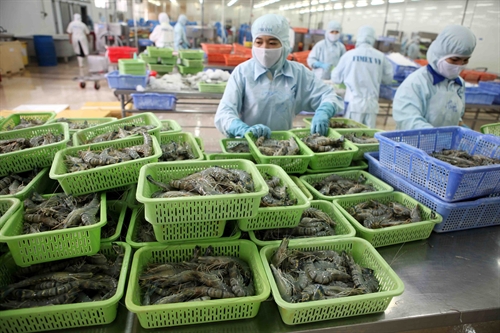 Economy
Economy

VASEP raises voice against US DOC’s decision on shrimp anti-dumping tax
 |
| Workers of Fimex Việt Nam Co in the southern province of Sóc Trăng process shrimp for export to Japan, South Korea and the US. Higher anti-dumping duties on Vietnamese frozen warm-water shrimp exports levied by the United States Department of Commerce (DOC) will affect businesses and shrimp farmers in Việt Nam – VNA/VNS Photo An Đăng |
HÀ NỘI — Higher anti-dumping duties on Vietnamese frozen warm-water shrimp exports levied by the United States Department of Commerce (DOC) will affect the psychology of businesses and shrimp farmers in Việt Nam.
This was the assessment of the General Secretary of the Viet Nam Association of Seafood Exporters and Producers (VASEP) Trương Đình Hòe.
In response to the DOC’s final decision that Vietnamese products will be taxed at 4.78 per cent during the 10th administrative review (POR 10), Hòe said this was a significant increase compared with previous reviews.
Under the decision, the US had increased the duty rate for Vietnamese shrimp in POR10, from 0.91 per cent in the POR9 to 4.78 per cent at present, for both mandatory and voluntary businesses. Meanwhile, the tariff imposed on other Vietnamese firms or exporters not examined as mandatory or voluntary respondents in the POR10 remains at 25.76 per cent.
Hòe said one of the main reasons leading to the high tax at POR10 was that DOC utilised a zeroing method to determine dumping margins, which many foreign experts consider unfair. This method was inconsistent with the rules of the World Trade Organisation (WTO), in which Việt Nam and the US are both member countries.
With this “chink’, Hòe said VASEP was studying the ruling, to possibly issue a complaint to the US State Court of International Trade, in order to require DOC to rethink its calculation method of the anti-dumping tax rate in the POR10.
“We hope that with the WTO’s recent verdicts in applying price discrimination, Vietnamese businesses can reach a tax of zero per cent and prove that they have not sold shrimp at dumping prices in the US market,” said Hòe.
In the POR10, DOC continued to choose Bangladesh and India as the main reference countries to fix the prices of several input materials. The two countries do not have many similarities with Việt Nam, leading to increased anti-dumping margins, said Hòe.
Chairman and Director of Thuận Phước Seafoods and Trading Corporation, Trần Văn Lĩnh, said the DOC’s increase of the anti-dumping tax rate had caused difficulties for Vietnamese producers and shrimp farmers. With the current conditions, the cost of Vietnamese shrimp resulted in domestic producers is no longer able to compete with its rivals, such as Thailand, Indonesia, India and Ecuador.
He noted that although the country’s shrimp industry had been rapidly developing, it lacked independence and remained unsuitable for development because businesses had to import adult shrimp and feed. In addition, the rate of successfully raised shrimp in Việt Nam was 30 to 35 per cent, which is much lower than in rival countries.
As for domestic competition, Lĩnh said Minh Phú Group was a giant in Việt Nam. Its exports of shrimp to the US had accounted for nearly 30 per cent of the country’s exports. The group did not have to suffer anti-dumping taxes from the US, making it very difficult for other Vietnamese companies to compete with Minh Phú.
“To maintain market share in the US market, businesses will have to continuously reduce prices, and finally shrimp farmers will have to bear heavy losses,” said Lĩnh.
According to statistics from VASEP, Việt Nam has, so far, earned nearly US$600 million from the export of shrimp since early this year, resulting in a year-on-year increase of 14 per cent. The export increased partly because of POR9’s lower tax rate of 0.91 per cent.
The US is Việt Nam’s largest importer of shrimp, accounting for 22.7 per cent of export market share.
Hòe said the export of shrimp to the US did not only depend on low and high anti-dumping duties, but also other factors, such as quality, supply capacity, market situation and the supply-demand capacity of other export countries.
“Therefore, for the long-term, businesses and shrimp farmers need to set up a systematic plan for production, processing and consumption of high-quality product, as well as maintaining a stable number of customers. With this, it will not likely be affected by an anti-dumping tax or other technical barriers from import countries,” said Hòe.
VASEP predicted that the country’s export value would reach about US$3.2 billion this year, increasing by 11 per cent, compared with last year. — VNS




